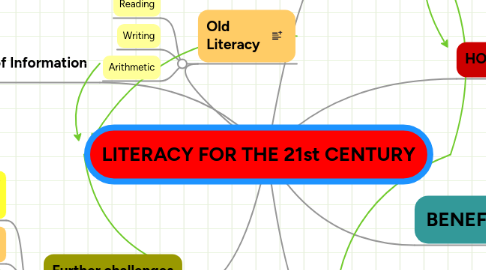LITERACY FOR THE 21st CENTURY
by Graciana Boettner

1. Old Literacy
1.1. Reading
1.2. Writing
1.3. Arithmetic
2. New dynamics of Information
2.1. Fast pace
2.1.1. Cellphones, Computers, Twitter, Search engines
2.2. Instant feedback
2.2.1. Twitter, Text messages, Emails, Facebook
2.3. Constant output and retrieval of information
2.3.1. Computers, cellphones, Internet, Wikipedia, Search engines, hyperlinking, tagging
2.4. More efficient methods of communicating
2.4.1. Youtube, Emails, Skype, Facebook, Twitter
3. Further challenges
3.1. Not being able to have access to technology and optimal methods of teaching and learning
3.2. Greater competition among people in order to succeed
3.3. Greater and more noticeable differences between those that are literate and those that are not
3.4. Not all technology is tried and true. Some may stay for a while, others may go away just as fast as they came.
4. HOW TO ATTAIN GOALS
4.1. Incorporate more games into curriculum
4.2. Keep students engaged, avoiding "down" time as Dr. Welsh suggests
4.3. Make learning meaningful
4.4. Teach students to teach themselves (David Warlick, Defining Literacy 2.0)
4.5. Promote connections between students and the teacher (Dr. Welsh)
5. CHALLENGES
5.1. For STUDENTS
5.2. For TEACHERS
5.3. For LIBRARIES
6. GOALS
6.1. Extract meaning and truth from information
6.2. Efficient decision-making
6.3. Incorporate and apply knowledge of latest forms of information adquisition
6.4. Communicate and present effectively
7. BENEFITS
7.1. Up to date information
7.2. Easier and faster communications
7.3. More interaction between people and cultures
7.4. More awareness of the world around us creating the sensation of a "shrinking planet"


